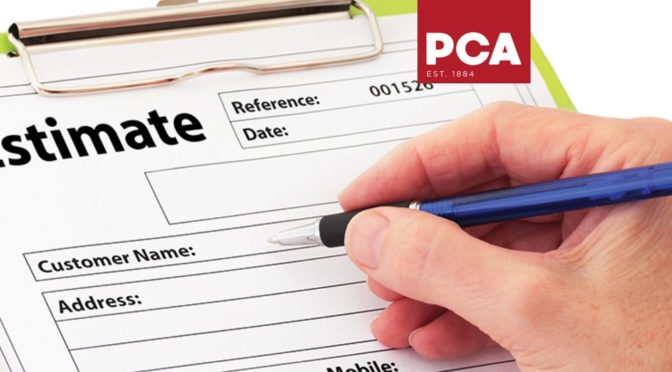Once again in 2023, Pintor Pro is teaming up with the Painting Contractors Association (PCA) on a series of articles to help you grow and improve your painting business. This year’s theme: Productivity is the path to profitability. In this article, Jon Bryant, CEO of Paint Scout, shares his secrets for foolproof estimating.
Creating a rock-solid estimating process
Effectively estimating the costs of a project is key to running a successful business. However, estimating a painting project is not as simple as it may seem and that’s a problem.
Estimating too high can lead to lost bids, while estimating too low can result in financial losses. It’s important to create a rock-solid estimating process that factors in everything from the cost of labor and materials to overhead and profit. This will save you time, money, and headaches down the line.
So, whether you’re a seasoned pro or just starting out in the industry, this article will outline some key tips and strategies to help you quit guesstimating and start effectively estimating using time-based rates.
Step 1: Collect the data
To avoid throwing out wild guesses or ballpark figures when pricing a painting project, it’s important to base the estimate on the specifics of the project. This means collecting the information about what surfaces you are being asked to paint, how much/many of them there are, and what condition they are in. By doing this it will allow you to have a reason behind your estimates and help to avoid issues like undercharging, overselling, or failing to make a profit.
The first step to getting the data is to conduct a site inspection to get a clear understanding of what the project entails. This inspection can be done in person or virtually, but an in-person inspection offers the benefits of allowing you to see the condition of the space, develop a relationship with your customer, and get a better understanding of the project’s needs.
During the site inspection you will be itemizing the areas that require painting; you’ll need to collect raw data on the surfaces that need painting (e.g., the number of doors, the square feet of drywall, the square feet of ceiling, etc..). This can be done by measuring the surfaces that need painting, ideally with a laser measurer, and counting up the number of items like doors and windows.
After compiling the data, make sure to take note of any other variables that might impact the project. Here are some questions for you to consider:
- How many coats of paint need to be applied?
- How much prep work is required? Sanding, patching, priming?
- Is the space difficult to access and will it require more time to set up and paint?
All these variables will affect how long the project will take which is the key to a successful and profitable project. So be sure to take note!
Step 2: Understand how long the project will take
Once you have collected the project data, it’s time to determine how long the project will take. This is the main foundation to determine how much the project will cost.
The best way to figure this out is by using time-based rates (also known as production rates).
A time-based rate is determined by how long it takes your team to complete a task. Once you know how long it takes for your team to do a task, you can estimate how long it will take them to complete the project accurately.
Here’s a quick example:
- Look at how many square feet of drywall and how many coats your team can paint in an hour.
- Once you have your time-based rates, you can use them to determine how long a project will take based on the data you collected.
For example, if your team can apply two coats of paint on 100 square feet of drywall per hour, and the project requires your team to paint 2,000 square feet of space, then you know it will take your team 20 hours to complete the project.
PRO TIP: It’s worth noting that while time-based rates are an excellent starting point, they may not always be accurate for every project.
Factors like how much prep work is needed, how difficult it is to access the project, and the type of paint being used will impact the time it takes. In such cases, add time for these elements separately or adjust your rates to account for these variables.
And if you’re unsure about time-based rates, the PCA Cost & Estimation Guides are a great place to start. These guides will help direct you on how to get started with time-based rates and guide you on how to collect your data to give an effective estimate.
The Paint Calculator, available in the Sherwin-Williams PRO+ App, can be used for collecting the dimensions, number of doors, number of windows to determine the square footage and approximate number of gallons needed for the project.
Step 3: What should you charge per hour?
Once you know how long your team will take to complete a painting project, it’s time to figure out how much you should charge per hour. Consider your hourly rate as a direct reflection of your entire business wrapped up into a single hour.
Your hourly rate should reflect all your costs of doing business, including labor, overhead, and profit (and sometimes materials):
- Labor: This covers the cost of paying your employees, including any benefits and payroll taxes.
- Material: This covers the paint and sundries used on the project. While you may want to charge these costs separately from your hourly rate, there are many contractors who prefer to include this cost in their hourly rate. Ultimately it boils down to personal preference and what works best for your business.
- Overhead: Make sure to factor in overhead costs, such as rent, insurance, utilities, and equipment.
- Profit: You probably want to make some money, right? Your rate should allow you to make a profit on each project, which is essential for the long-term success of your business.
PRO TIP: Keep in mind that profit is different from markup – while markup refers to the percentage added to the cost of a product or service, profit is the amount of money left after all expenses have been paid.
Step 4: Add it up
Now that we have assessed how long the project will take, and what to charge per hour, it’s time to add it all up.
Take the hours estimated for the project and multiply them by your hourly rate (adding materials either through your hourly rate or separately)
For example:
If you’re painting two coats on 2,000 square feet of drywall and your team paints 100 square feet an hour to accomplish this, then the project will take 20 hours.
If your hourly rate is $70/hour then you simply multiply 20 hours by $70/hour to get a total cost of $1,400. If you didn’t include materials in our hourly rate, then you need to add those in separately. Say that cost is $175 – then you add this to the $1,400 estimate of labor to get an all-in estimate of $1,575 for the project.
PRO TIP: Want help growing your business and improving productivity? Look to the Sherwin-Williams PRO+ App – which includes the easy-to-use Project Bids tool. Read more in our article The PRO+ App – Letting You Focus on What You Do Best.
Estimating painting projects doesn’t have to hurt
Effectively estimating a painting project can be a lengthy process if done incorrectly. Consider using an estimating software to help streamline the process and avoid errors.
PRO TIP: Save time with digital tools that can collect project details, help calculate and deliver professional-looking estimates to your customer. Project Bids in the Sherwin-Williams PRO+ App is a free, easy-to-use estimation tool offered by Sherwin-Williams. Other estimation tools are available in the market as well.
Lastly: Review, revise, refine
Once you have completed a project, it’s important to review the estimate compared to the actual project so you can make future improvements to your processes. This way, you can identify any areas where you overspent or underproduced, where your initial estimate was inaccurate, or areas where you can adjust your time-based rates to better reflect your team’s capabilities.
For example, if a particular task took longer than estimated, consider whether it was an unforeseen complication or if you need to allocate more time for similar tasks in the future.
By reviewing and refining your estimates on a regular basis, you can increase the effectiveness of your estimating process, which will leave you feeling confident in the prices you provide.
Let’s recap
To sum things up, effective estimating is a critical part of running a successful painting business.
By developing a process that uses real data to assess projects, and then translating projects into the time they take, you will be able to more effectively estimate projects with less risk to your business. Then save time by implementing software tools to make the process easier. Finally, by reviewing, revising and refining your estimating process, you can improve the accuracy of your estimates and increase your chances of winning bids that make a profit.
This article was written by by Jon Bryant, CEO of PaintScout, and published in the Summer 2023 issue of Pintor Pro magazine. ©2023 Randall Reilly. It was developed in conjunction with the Painting Contractors Association (PCA), a trade association partnering with PPC to produce an ongoing series of articles to help painting company owners grow their businesses. Visit PCApainted.org for more resources designed by painters, for painters.




